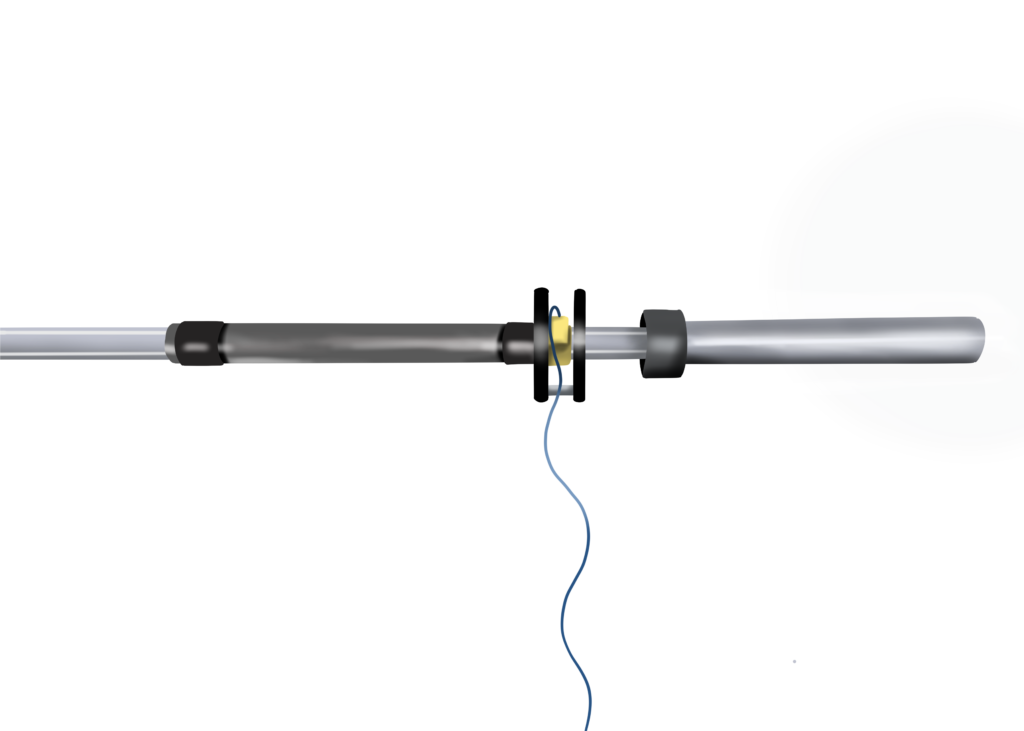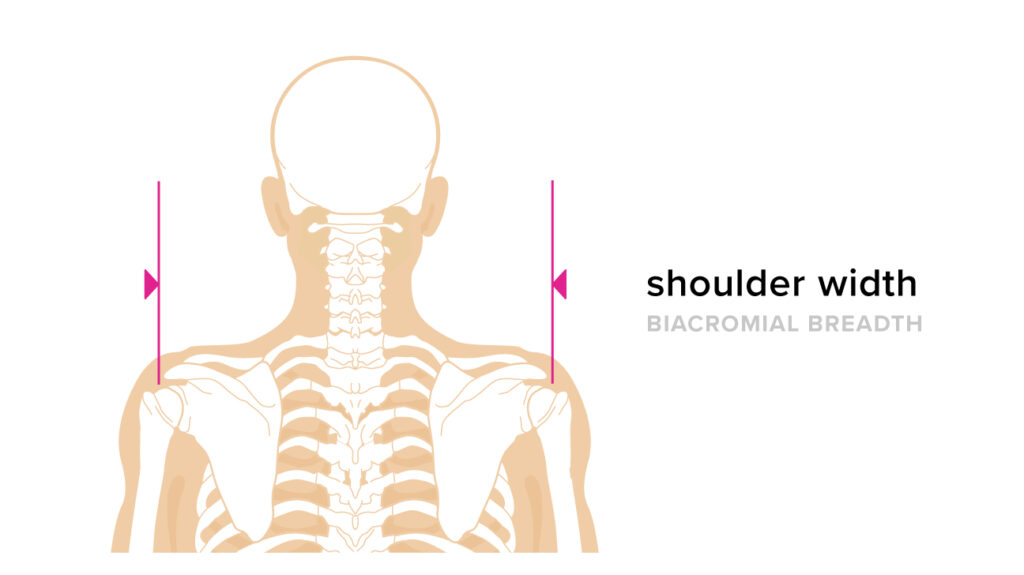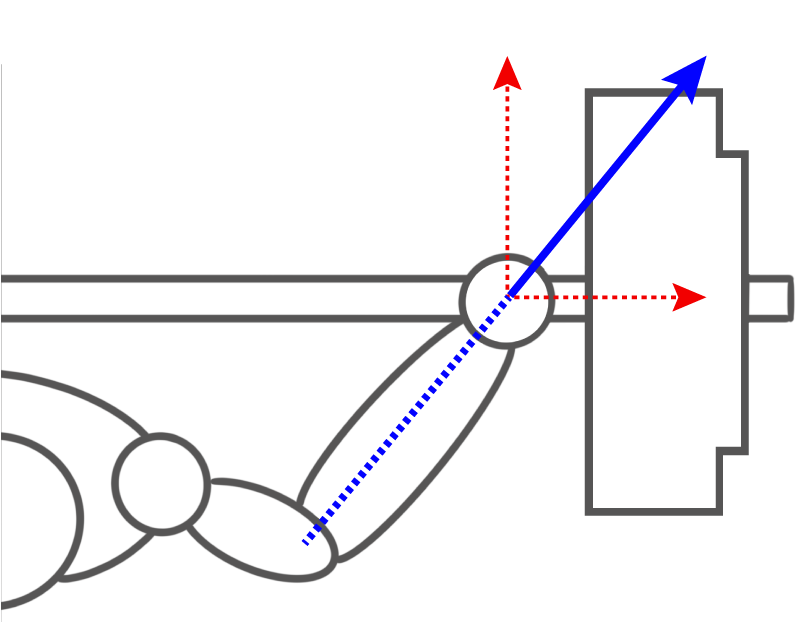How much do you bench? Let’s face it, the bench press is probably the primary upper body strength yardstick almost anywhere you go. For powerlifters, it is the one and only test of upper-body strength. Even those strong in the other two lifts will need proficiency in the bench for an exceptional total. So let’s put our reading glasses on and see if we can extract any valuable nuggets from this research paper that might help improve bench press performance.
Key Points
- Use mixed width grips during regular training for shoulder and elbow longevity.
- Test 1RMs with a medium or wide grip.
- Try both if your sticking point is near lockout.
- A wide grip is probably more technically challenging.
- Try variations of the wide grip (e.g., tempos, boards, variable resistance).
- Try more rep ranges with a medium and narrow grip.
- Bicep training might help a wide grip.
Frontiers in Sports and Active Living · January 2021
Stian Larsen, Olav Gomo and Roland van den Tillaar
Study Purpose
Grip width has been shown to affect 1RM results, with a wider grip typically favoring higher results.
A sticking region will occur at weights above 90%1RM in the bench press. This region spans the range of motion where most lifts fail and is defined as the portion of the ROM where the net vertical force on the bar is downward. This net downward force causes the bar to slow down and potentially stop, resulting in a failure to complete the lift. The underlying causes of the sticking point have been of great interest to researchers since at least 1984 (Madsen and McLaughlin) when it was proposed that the sticking region is due to the involved muscles being in poor mechanical force positions. This transient sub-optimal positioning temporarily reduces their capacity to exert force. In 2012, Tillaar et al. tested this hypothesis and suggested the sticking point could be due to the force-length relationship of the involved muscles. Specifically, that joint angles in the sticking region are such that the muscles cannot exert maximum force. This hypothesis was then tested in 2016 by Gomo & Tillaar by comparing the sticking point in the bench press using different grip widths. They expected to see sticking points matched with similar joint angles among the tested grip widths. While this was not observed, the hypothesis has not been entirely ruled out. The authors only looked at the vertical force component on the bar. Meanwhile, it has been shown that there are also horizontal forces acting on the bar. In some cases, up to 26% (Duffey & Challis, 2011) of the total force on the bar is along the horizontal axis.
Therefore, this study aimed to characterize the vertical and horizontal forces on the bar at three different grip widths. At the same time, the authors wanted to see the corresponding changes in muscle activity before, during, and after the sticking point.
They hypothesized that some of the total force on the bar would bleed off along the horizontal axis during the sticking region, thus diminishing the vertical force on the bar and inhibiting its upward movement.
Experimental Setup
Force Measurements
A force plate under the bench measured vertical reaction forces of pressing against the loaded barbell. A modified barbell (Figure 1) was constructed to measure horizontal forces on the barbell. A sleeve over the tested grip area connected to a load cell and transmitted the horizontal force data during the execution of the 1RM tests.
1RM Tests
The authors recruited 14 males with at least three years of bench press training experience. Subjects were required to have a 1.2x BW bench press at the very minimum and were randomly assigned an order to perform wide, medium, and narrow grip bench press 1RM tests. Grip widths were defined as follows:
- Wide grip: 1.7x biacromial distance
- Medium grip: 1.4x biacromial distance
- Narrow grip: 1x biacromial distance
Participants conducted a standardized warm-up protocol of eight reps at 40% of self-estimated 1RM, six reps at 60%, three reps at 70%, and two reps at 80%. Subjects were then tested at 95% and 100%. If a 1RM attempt was successful, another attempt was made with an additional 2.5kg or 5kg on the bar after a 5-minute rest. Three attempts were made at each grip width.
Muscle EMG Recordings
To see if there were any associations between muscle activity and force output along the range of motion, the authors aligned electrodes with the direction of the muscle fibers over the muscle bellies of the pectorals, deltoids, triceps, and biceps.
3D Motion Capture
Eight cameras were used to track 3d motion at a frequency of 500Hz. The resulting data were used to compute moment arm lengths at the elbows and shoulders for the three tested bench press grip widths.
Findings
Wide and medium grip bench press 1RMs did not significantly differ from each other and were significantly higher than narrow grip bench press 1RMs. Maximal velocity, as well as vertical displacement, increased as grip width narrowed.
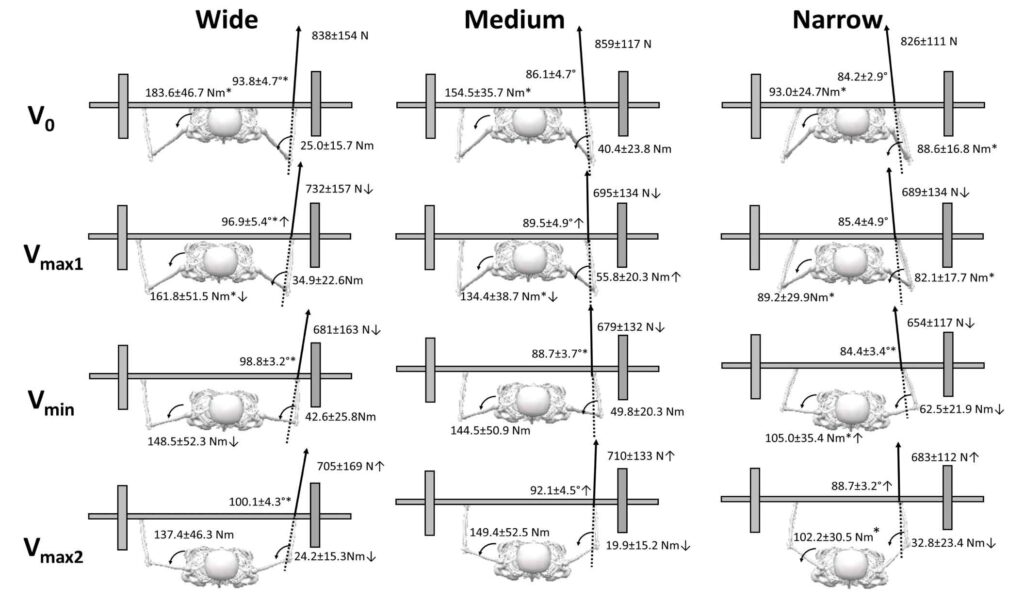
Force Vectors
| Grip | Force Angle (degrees) | Elbow Moment (Nm) | Shoulder Moment (Nm) | Resultant Force (N) |
| Wide | 98.8 | 42.6 | 148.5 | 681 |
| Medium | 88.7 | 49.8 | 144.5 | 679 |
| Narrow | 84.4 | 62.5 | 105.0 | 654 |
The resultant force angle deviated from vertical most prominently in the wide grip bench press at the end of the sticking point (98.8 degrees, Table 1). The larger force angle resulted from greater lateral forces (outward horizontal force component) as compared to the medium (neutral horizontal force component and 88.7 degrees) and narrow grip (slight inward horizontal force component and 84.4 degrees).
Moment Arms
The wide grip bench press resulted in the largest moment arm for the shoulders and smallest for the elbows (Table 1). Meanwhile, the narrow grip showed the opposite relation, with a small moment arm for the shoulders and a large moment arm for the elbows. The medium grip had moment arms intermediate between the two.
Not sure what force vectors and moment arms are? Skip to the end for a brief recap.
Muscle EMG Regional Changes
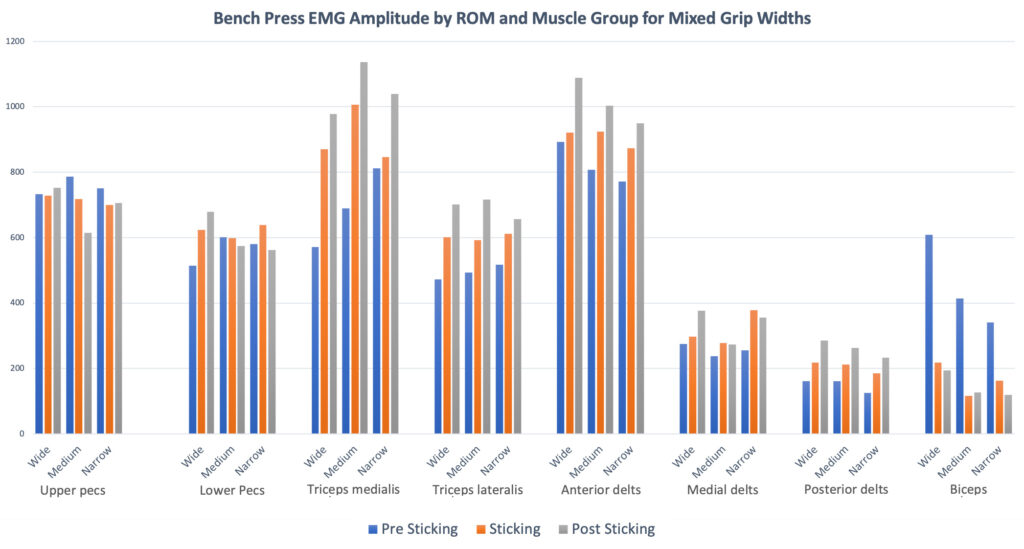
Force angle and moment arm changes were also compared across the range of motion (Figure 3). Key landmarks in the ROM are the starting position, entry to the sticking region (Vmax), and recovery from the sticking region (Vmin).
- Pre-Sticking = Starting position > Vmax
- Sticking = Vmax > Vmin
- Post-Sticking = Vmin > Ending position
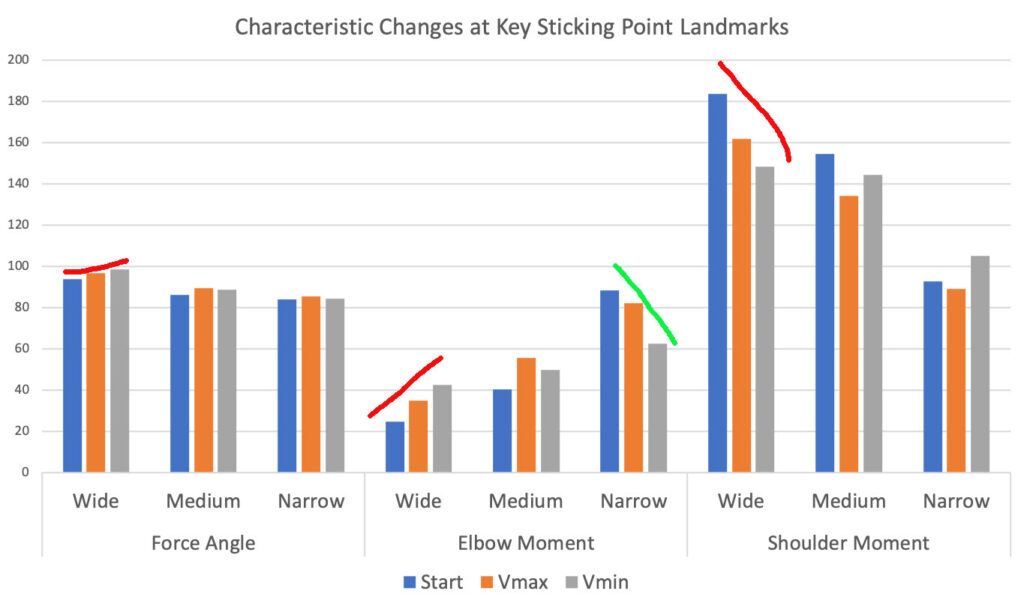
The results in Figure 4 show significant changes across the ROM in only the wide grip bench press. The continuous changes in force angle, elbow moment arm, and shoulder moment arm suggest a more technically challenging grip variation.
Note that triceps activity increases across the ROM in all cases (Figure 3), yet only in the wide grip does the elbow moment arm (Figure 4) follow the same pattern. The correlation between increasing tricep EMG and increasing elbow moment arm length in the wide grip bench press means the additional effort does not contribute to greater vertical force due to changes in the force angle near lockout. Meanwhile, with a medium grip, the additional triceps EMG does slightly increase vertical force. Contrast that with the narrow grip, which shows similar increases in triceps activity, increasingly favorable elbow moment arm lengths near lockout, and yet no significant gain in force near lockout. The combination of harder working muscles and improved leverages, yet no increase in force suggests that triceps fatigue diminishes force during the lift.
Conclusion
The study results did not support the authors’ hypothesis that the sticking point results from a reduction of force due to horizontal forces at the sticking point. Nevertheless, the kitchen sink approach to collecting data on the bench press still makes this an interesting addition to the literature.
Take Away Points
Resultant force seems to depend most on shoulder moment arm length (i.e., favoring wider grips). A more extended moment arm places increased stress on the prime movers closer to the center of the body (e.g., pectorals and deltoids) and less stress on the prime movers further away (e.g., triceps).
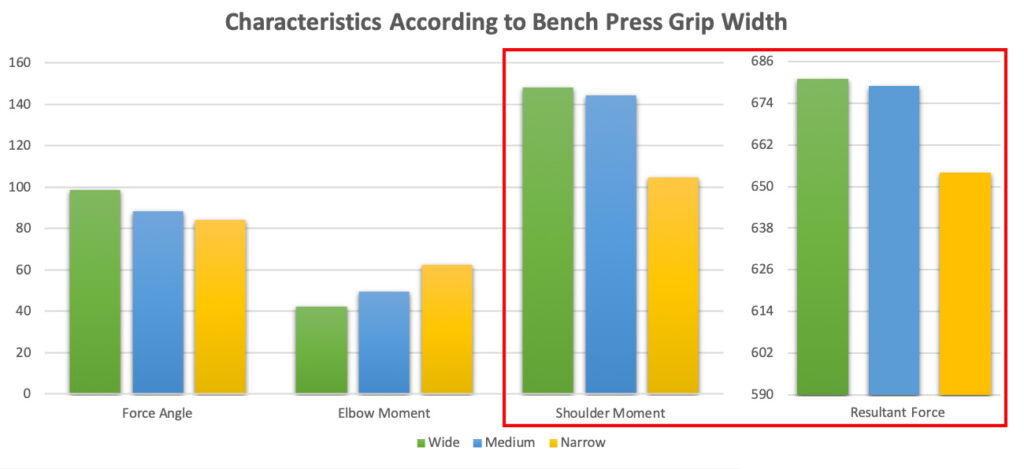
While theoretically wider is better, it should be noted that optimal grip width, which maximizes bench press results, can vary over time. Joints can experience varying degrees of readiness across a training cycle (e.g., unwanted shoulder or elbow pain), and technical proficiency, as well as muscular force, can ebb and flow with training and detraining. Optimal grip width is, therefore, probably better expressed as a range.
Test 1RMs with a medium to wide grip
Measure your biacromial width (Figure 2) and test grips between 1.5-2x biacromial width. As an alternative to testing 1RMs, you could try using the Velos-ID and seeing which grip generates a higher e1RM when using 80% of your current 1RM.
The machine learning algorithms in Sheiko Gold will factor in the greater velocity of longer ROMs when generating your e1RM. Note that you want to compare e1RMs and not velocities between the different grips.
Try variations of the wide grip (e.g., tempos, boards, variable resistance)
Wider grips are likely to be more technically challenging due to the changes in force angles across the ROM and the resulting shifts in moment arm lengths. As such, wider grips are likely to benefit more from additional variations on top of the grip width (e.g., wide grip with a pause, wide grip with bands, wide grip board press, etc.). The slight alternation of lift stress profile and execution can contribute to more rapid skill acquisition.
Try more rep ranges with a medium and narrow grip
Since medium and narrow grips are likely less technical, they are probably more tolerant of the greater fatigue imposed by higher rep ranges. So if you love your higher rep sets, try doing them with a medium or narrow grip.
Use mixed grip widths during regular training for shoulder and elbow longevity.
Training with a blend of grip widths across a training cycle can potentially help avoid overuse joint injuries (e.g., shoulders and elbows) due to differences in the moment arm lengths. Greater push variety may be a preferable strategy over reliance on pulling exercises since the opportunity cost of adding additional pulls means fewer pushes.
| Option 1 | Option 2 | |
| Monday | Medium Grip BP | Wide Grip BP |
| Wednesday | Pull-Ups | Narrow Grip BP |
| Friday | Medium Grip BP | Medium Grip BP |
The reported benefits of Option 1, which attempts to balance pushing and pulling, may not be attributable to correction of “strength imbalances” or “volume equalization” but simply a result of deloading the bench. With Option 2, joint deloads are built in as the moment arm varies. This can result in a higher level of sustainable pushing volume.
Bicep training might help a wide grip.
Flat bench dumbbell flyes might be increasingly valuable as bench press grip width expands. The bottom portion of the fly ROM mimics the biceps position and pectoral stretch at the starting position of a wide grip bench. The biceps act as dynamic stabilizers in the initial ROM in both cases. Resistance in the form of dumbbells may enhance the training effect on stabilization.
Force Vectors and Moment Arms Recap
The vertical dotted line in red represents the vertical force as measured by the force plate under the bench. The longer the line, the greater the force. The horizontal red dotted line shows the force picked up by the load cell on the modified barbell (Figure 1). The solid blue line indicates the overall force vector when the horizontal and vertical components are added together.
Why is this important? The bar moves up due to the vertical force. More is better.
The dotted blue line shows the path of the force vector extended through the joints and is used to calculate moment arm lengths. In this diagram, the blue line seems to pass through the elbow. This would result in a near zero moment arm (distance from the joint to the dotted blue line) for the elbow and a larger moment arm for the shoulder.
IMPORTANT NOTE: This 2D diagram is exaggerated for illustration purposes and does not show how far the dotted blue line may be from the elbow in a side view. The actual elbow moment arm may be significantly greater.
Why is this important? A shorter moment arm allows you to lift more weight than a longer one given equal muscular force on the joint.
